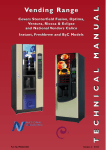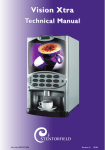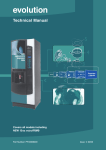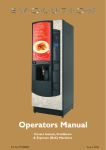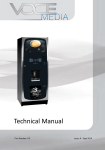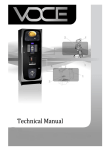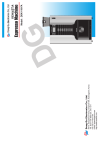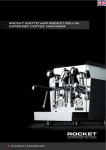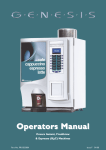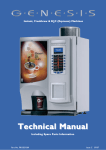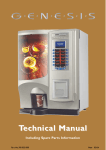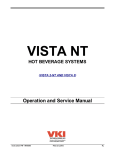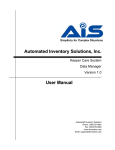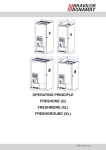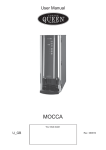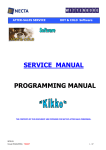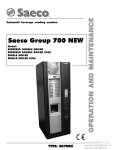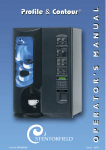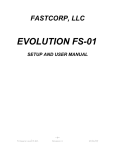Download Horizon Technical Manual - Crane Merchandising Systems
Transcript
M A N U A L T E C H N I C A L Horizon Part No. PR06743000 Rev A 11/02 Technical Manual Contents Page No. Introduction ...................................................................................................2 Important Safeguards ...................................................................................2 Specification....................................................................................................3 Water Filter - Where Fitted.......................................................................3 External Features ..........................................................................................4 Internal Features ...........................................................................................5 Section 1 - Installation Procedure ............................................................6 Section 2 - Programming The Machine .................................................10 Section 3 - The Vend Cycle ......................................................................30 Section 4 - Technical Information ...........................................................38 Section 5 - Electrical/Electronic Information .......................................41 Section 6 - Figures and Diagrams ...........................................................48 The following symbol is used throughout this Technical Manual: Safety First! Take care, risk of personal injury. © Copyright 2002 Crane Merchandising Systems 1 Technical Manual Introduction This manual is to be used by authorised personnel involved in installing, commissioning and servicing the Horizon table-top beverage system. The technical information contained within this document is for information only and may be changed without prior notice. Crane Merchandising Systems accepts no responsibility for any damage caused to the machine through misinterpretation or misuse of the information contained in this document. Upon receipt, carefully examine the machine checking for any damage or missing/incorrect parts. Any discrepancy must be reported to Crane Merchandising Systems in writing within three working days. In accordance with the food hygiene regulations and in compliance with local Public Health Authorities, it is the responsibility of the operator to keep the machine in a thoroughly clean condition. Important Safeguards When installing or servicing the Stentorfield Horizon, always have this manual available for quick and easy reference and always follow these basic safety precautions: 1. Ensure that the machine is situated on a strong horizontal surface, at a convenient height and in a position where it is not likely to be knocked off. 2. The mains lead should never trail from the machine and should always be kept away from hot surfaces and sharp edges. 3. Allow the machine to cool before handling or moving. 4. Ensure that the mains electricity supply is isolated before removing any of the protective panels or undertaking any major servicing.Working on live equipment should only be undertaken when there is no practical alternative. 5. Never clean or service the brewer unit fitted to freshbrew machines whilst it is in motion as fingers may become trapped in the mechanism. 6. When servicing the heater tank be aware that water in the tank can reach a temperature of approximately 96° C.Water at this temperature can cause severe burns. 7. Never immerse the machine in water, or any other liquid.This machine must not be installed in an area where a water jet may be used. Never use a water jet to 2 Technical Manual clean this machine. 8. In normal operating conditions the machine should not freeze-up. In the unlikely event of the machine freezing, turn off the mains water supply, disconnect the machine from the mains electricity supply and contact Crane Merchandising Systems for assistance. 9. Ensure that you are conversant with the ‘Health and Safety at Work and Electricity at Work Regulations 1989’. This machine is for indoor use only and because it is a food machine, should be situated in a clean, hygienic area. Specification Height Depth Width Weight Electrical Services (i) Voltage (ii) Current (iii) Frequency Water Services (i) Pressure (ii) Stopcock Base (i) (ii) (iii) Cabinet (Optional) Height Width Depth Instant and Freshbrew 870 mm 510 mm 450 mm 60 kg 220 - 240 Volts AC 13 Amp Fused 50 Hz 100 Kpa (1 Bar) - 800 Kpa (8 Bar) 15 mm BSP from rising main 900 mm 770 mm 533 mm All weights and dimensions are approximate and are for guidance only. Water Filter - External Fitment (where fitted) The machine may be fitted with either an Everpure or Brita filter head and filter cartridge. This unit will be located either within the machines base cabinet (where applicable) or in the water supply line. To maintain optimum drink quality, the cartridge should be replaced every six months or earlier, depending upon the number of vends. 3 Technical Manual External Features 1 2 STENTORFIELD 3 7 4 5 Horizon 8 6 9 Note: Illustration shows numeric keypad version. Key: 1. Door 6. Coin Return (where fitted) 2. Coin Entry (where fitted) 7. Door Lock 3. Selection Decals 8. Cup Stand 4. LCD Display 9. Drip Tray 5. Keypad 4 Technical Manual Internal Features 6 5 7 4 8 9 3 10 11 12 13 2 1 14 Note: Illustration shows freshbrew interior. Key: 1. Drip Tray 2. Floor Liner 3. Mixing System 4. Large Ingredient Canister 5. Loom 6. Function Switches 7. Small Ingredient Canister 8. Door Switch 9. Coffee Canister (Freshbrew machines only) 10. Coffee Brewer (Freshbrew machines only) 11. Dispense Spouts 12. Dispense Head 13. Freshbrew Waste Bucket 14. Drip Tray Grill 5 Technical Manual Section 1 - Installation Procedure Important! It is essential that personnel responsible for installing, commissioning and servicing the machine understand the following: 1. The installation and commissioning of the machine should only be carried out by trained and authorised service engineers. 2. All water and electrical services must be correctly and safely connected. 3. All covers should be replaced correctly and securely and the machine left in a safe condition. 1.1 Installing the Machine 1. The machine is suitable for indoor use only, sited in an area with a recommended ambient temperature not below 10º C and not exceeding 30º C. 2. Prior to moving the machine to its location, ensure that there is sufficient access space available via passageways, stairs, lifts, etc and that the table/counter where the machine is to be located is strong enough to safely support its weight. (Refer to Specifications Table). 3. The machine should be located near the appropriate water and electrical services as detailed in the specification table. 4. To ensure adequate ventilation, 100 - 150 mm (4 - 6 inches) clearance must be allowed between the back of the cabinet and the wall. 5. Unlock and open the cabinet door. Remove all transit packing and the installation kit from the machine. Check for visual signs of damage which may have occurred during transit. 6. If the machine is damaged or any parts are missing, you must contact the supplier immediately. 7. The machine should be levelled in both front to back and side to side planes using the four adjustable levelling feet (12 mm thread). Check for correct alignment using a spirit level placed on the floor of the machine. 6 Technical Manual Note! Incorrect levelling can result in: (a) Door misalignment. (b) Coin acceptance reduction. 1.2 Connecting the Water Supply 1. The machine should be situated within 1 metre of a drinking water supply from a rising main, terminating with a W.R.C. approved 15mm compression stop tap. 2. The water supply should comply with both the Statutory Instrument No.1147 “Water, England and Wales” and The Water Supply (Water Quality) Regulations 1989.Water pressure at the stop tap must be within the limits 1 - 8 Bar (100 Kpa 800 Kpa). 3. Connect the flexi-hose supplied with the machine to the stop tap ensuring that the seal supplied is fitted correctly.Flush the system via the stop tap (several gallons) before connecting the hose to the machine. 4. Connect the hose to the inlet valve located on the rear of the machine. Ensure that the seal is correctly fitted. Ensure that all water supply fittings are tight.Turn on the stop tap and check for leaks. 1.3 Connecting the Electricity Supply Safety First! THE MACHINE MUST BE EARTHED. ON NO ACCOUNT SHOULD IT BE EARTHED TO THE WATER SUPPLY PIPE 1. The machine must be connected to a 240 Volt 50Hz 13 amp fused switched socket outlet, installed to the latest edition of the IEE regulations, using a 3 pin BS approved 13 amp fused plug. 2. Machines are despached from the factory with the input transformer connected for a 240 volt supply. If the electrical supply differs, the alternative tapping (230 volt or 220 volt) should be used. Important: If the mains lead becomes damaged in any way it must be replaced by a special lead available from the manufacturer. 7 Technical Manual 1.4 Commissioning Procedure The following procedure must be carried out by a trained installation engineer before the machine can be used for the first time. 1. Ensure that the electrical and water services to the machine are connected correctly and turned on. Ensure that the waste tray is fitted correctly to the machine. 2. Open the front door of the machine. Insert the safety key supplied with the machine into the door switch.The machine is now on. 3. Whilst the boiler in the machine is filling, the display will show the message: SORRY NOT IN USE LOW WATER 4. As the water in the boiler starts to heat, the message on the LCD will change to: SORRY NOT IN USE WATER HEATING 5. Ensure that no water overflows from the boiler tank overflow pipe into the waste tray. Check the system for leaks. Safety First! Should the machine fail to fill correctly or leak, turn off the stopcock and contact the machine supplier for assistance. 6. Check the LCD display on the front of the machine to ensure that the water has heated to the correct temperature and that the machine is in standby mode.The display will show the message: PLEASE SELECT DRINK TIME XX:XX Where XX:XX is the current time. 7. Remove the ingredient canisters - DO NOT place ingredient canisters on the floor. Remove the lids from the ingredient canisters. Fill the canisters with the correct ingredients, re-fit the lids and re-fit canisters into machine. 8. 8 Referring to Section 2 of this manual,“Programming The Machine”, use the menu Technical Manual selections available in the operator’s and engineer’s programs to program the required settings for correct machine operation. 9. Press the test vend switch, located in the switch panel mounted above the ingredient canisters, to check that the machine operates correctly. Place an empty cup under the dispense head before vending the selection. 10. If the machine is fitted with a coin/card mecahanism, check that the mechanism and cash box operate correctly. 11. Remove the safety key. Fit the door switch bracket to the door using the two screws provided. Ensure that the bracket will operate the door switch when the door is closed. Check for leaks and ensure that the machine is left in a clean and safe condition. 9 Technical Manual Section 2 - Programming The Machine 2.1 Modes Of Operation The machine has three operating modes: 1. Standby Mode - The machine is ready to dispense a vend and displays the time and type of credit input required. This is followed by the vend cycle and a return to the standby mode. 2. Operator’s Program - Accessed by pressing the program switch and then entering the operator’s code via the keypad. This enables the operator to access sub-programs in order to change information relating to time, drink, price periods etc. It is not possible to vend a drink from within the operator’s program. 3. Engineer’s Program - Accessed by pressing the program switch and then entering the engineer’s code via the keypad. The engineer may then access a number of sub-programs in order to alter the ingredient dispense and machine parameters or use the machine test facilities. 2.2 Programming Mode The Stentorfield Horizon may be fitted with either a single button selection keypad or a numeric keypad. Both keypads perform identical functions during programming. Numeric Keypad Single Button Selection Keypad 10 Technical Manual To access the programming mode you need to enter a sequence of key strokes on the keypad.The time between each key stroke must be less than 5 seconds otherwise the machine will return to standby mode. Once in programming mode there is no time constraint. During programming the buttons/keys are used as follows: 0-9 “C” Blank ▲ Used for data entry Used for correcting data and entering a higher program level For moving to a higher program level For indexing up in a program Normal ▼ For entering data in a program, or entering a lower program level For indexing down in a program Note: To avoid confusion, in this manual the Normal key will be referred to as the Access key. 2.3 Accessing the Programming Mode In order to enter the Engineer's or Operator's programs proceed as follows:1. Press the program entry switch, mounted in the panel located above the ingredient canisters, followed by the appropriate access code. Code entry errors may be erased using the cancel (C) key. 2. With the correct code entered the title of the first sub-program will be displayed on the LCD. In the engineers program the LCD will display the message: KEYPAD TEST SUB PROGRAM 3. To step through the sub programs, press either the up (▲) or down (▼) keys. 4. To access a displayed sub program, press the access (normal) key. 5. If any numerical data parameter is entered, it may be changed in one of two ways: (a) Pressing the up (▲) or down (▼) keys increases or decreases the number on each key press. (b) Keying in the actual digits of the number required. Using this method, the new number will be displayed in place of the current parameter. 11 Technical Manual 6. Once the correct number has been entered, press the access key to overwrite the old parameter with the new number.To retain the old parameter press either the ‘blank’ or cancel (C) key. Note: It is not possible to vend a drink in Programming mode. 2.4 Operator’s Program (Default 17) The nine sub-programs within the operator’s program are as follows:Drink Price Sub-Program Alternative Tariff 1 Sub-Program Alternative Tariff 2 Sub-Program Alternative Price Period Sub-Program Drink Disable Sub-Program Non Resetable Vend Counters Sub-Program Time/Date Sub-Program Self Clean Sub-Program Operator Code Sub-Program 1. Drink Price Sub-Program 1. The drink price sub-program allows the normal tariff prices to be individually set for each drink. 2. Upon entry into this sub-program, the name of the first drink (coffee) is displayed, followed by its price. 12 Technical Manual The LCD will display the following message: COFFEE PRICE = 10 N.B. Freshbrew machines will display coffee whereas instant machines will show tea. 3. To alter the drink price, press the access key. The LCD will display the following message: COFFEE PRICE > 10 4. The = symbol changes to a > symbol indicating that it is now possible for new data to be entered. Key in the new price using the keypad and when correct press access to overwrite the old data. 5. The prices for other drinks can now be set following the sequence described in 2.2 - Programming Mode. 2. Alternative Tariff 1 Sub-Program This sub-program works in exactly the same way as the drink price sub program and has the same appearance. The prices set in this program will be in force during tariff 1 periods. 3. Alternative Tariff 2 Sub-Program This is identical to the alternative tariff 1 sub-program except that the prices set here will be in force during tariff 2 periods. 4. Alternative Price Period Sub-Program This sub-program enables the times to be specified when each of the above tariffs should be in force.There is a four level tariff structure available: 1. 2. 3. 4. Normal Tariff: Prices set in the drink price sub-program and in force when no alternative price period is currently applicable. Tariff 1: Prices set in the tariff 1 price sub-program. Tariff 2: Prices set in the tariff 2 price sub-program. Tariff 0: Sets the machine into free vend. 13 Technical Manual The machine is factory set so that no alternative prices are available (i.e. the normal tariff is permanently in force).To change the tariff period, proceed as follows:1. On entry into this sub-program the display will show the message: P1 = 00 : 00 - 00 : 00 TARIFF - EVERY DAY 2. This is an empty price period.To enter a price period (e.g. 10:30 - 15:45,Tariff 2, Weekends), press access.The display will now read: START > 00 : 00 Note: The arrow symbol (>) indicates that it is possible to update the display. 3. Enter the correct start time in hours and minutes using buttons 0 - 9 on the keypad. Note: To correct any entry errors, press cancel to delete the last digit entered. Pressing cancel with no digits displayed will exit to the Operator’s program. 4. With the start time entered press access. Enter the finish time as described above and press the access key.The display will now show: PERIOD 10 : 30 - 15 : 45 TARIFF > 0 5. To set the tariff period, enter a number between 0 and 2 (or use the up (▲) or down (▼) keys) followed by access.The message will change to: PERIOD 10 : 30 - 15 : 45 TARIFF 2 > EVERYDAY 6. Using the up (▲) and down (▼) keys, index the day setting between “Every day”, “Weekdays” and “Weekends”. When the required day setting is displayed, press the access key to complete the price period data entry. The message on the display will read: PERIOD 10 : 30 - 15 : 45 TARIFF 2 EVERYDAY 14 Technical Manual 7. There are a maximum of ten possible price periods available. To enter another price period, use the up (▲) or down (▼) keys to view the periods until an empty period is displayed. The new period is entered in the same way as described previously. 8. If the start time is entered as being a later time than the finish time, the period will not be accepted by the machine. If periods overlap, the first overlapping period in the list will be the one in force until it has finished. To delete a period, continue as if that period were to be re-programmed, and when the display is requesting the start time to be entered, press cancel. 5. Drink Disable Sub-Program This sub-program allows drinks to be either enabled or disabled.The following example illustrates the sequence required to disable chocolate. 1. Enter the drink disable sub-program. 2. Scroll up or down using the appropriate arrow key until the message on the LCD display reads: CHOCOLATE = ENABLED 3. Press the access key.The message on the display will now read: CHOCOLATE > DISABLED 4. Press the access key again.The drink is now disabled. 6. Non Resetable Vend Counters Sub-Program 1. When the vend counters sub-program is entered, the first drink counter is displayed: COFFEE 1372 2. The up and down arrows enable the counters for each drink to be viewed, but they cannot be altered using the keypad.These counters can only be reset by using the “Reset Counters” switch. 3. There is one vend counter for each drink, plus counters for jug vends, free vends, 15 Technical Manual total vends and total sales value.The total sales data is displayed in units of 1 penny. 7. Time / Date Sub-Program The machine maintains a record of the current time and date in 24-hour format. The date is programmed for leap-year roll-over and should not require adjustment. To set the time and date, proceed as follows: 1. The Time/Date sub-program displays the time, date and day of the week. The up (▲) and down (▼) keys are used for viewing the three different messages. 2. To view the time, enter the time/date sub-program. The display will show the message: TIME = XX : XX where xx:xx is the current time. 3. To change the time shown, press the access key.The display will now show: TIME = XX : XX SET TIME > 00 : 00 4. Enter the correct time in hours and minutes using buttons 0 - 9 on the keypad. 5. When correct, press access. The time is now set. To view the date, press the up or down key until the display reads: DATE = XX : XX : XX where xx:xx:xx is the current date. 6. To change the date, press the access key.The display will now show: DATE = XX : XX : XX SET DATE > 00 : 00 : 00 : 00 7. Enter the correct date using the sequence day, month, year using buttons 0 - 9 on the keypad. 8. When correct, press access.The date is now set.To view the day, press the up or 16 Technical Manual down key until the display reads: DAY = XXXXXXXXX where xxxxxxxxx is the current day of the week. 9. To change the day, press the access key.The display will now show: DAY = XXXXXXXXX > XXXXXXXXX 10. Use the up or down arrow keys until the required day is displayed. Press the access key. The time, date and day are now programmed. 8. Self Clean Sub-Program The auto flush feature on the machine enables the operator to define two daily times at which the machine will flush through the water system. 1. The auto flush sequence is similar to the flush sequence initiated by the flush switch. The “Sorry Not In Use: Self Cleaning” message is displayed, the blocker enabled and the controller waits until the water is at the correct temperature set by the thermostat. In order to guarantee the highest standards of cleanliness, the boiler fill valve is disabled, ensuring that the water used in the self-cleaning cycle is kept at the optimum temperature to kill any germs which may have accumulated. 2. Each hot water valve is switched on in sequence for the specified flush time, (set in the miscellaneous settings program). While the valves are on, they are ‘rattled’ (to remove any limescale which may have accumulated on them) and their corresponding whippers are run. 3. Once the auto flush cycle is completed, the controller refills the boiler to the correct level. When the correct water temperature is obtained, the machine returns to standby mode. 5. Auto flush periods can be selected to occur everyday, weekdays, weekends or never. 6. To enter auto flush times, follow the sequence described for setting an "alternative price period" 17 Technical Manual 9. Operator Code Sub-Program (Default 17) Entry into the “operator code sub-program” enables the operator code to be changed. This code may be of any length up to seven digits. Enter a new code at the prompt and when correct press access. 10. Reset Counters Switch 1. This switch, operated from within the operator’s program, enables the operator to reset the vend counters to zero. When the “Reset Counters” function is activated, the machine will give an intermittent bleep and flash the following message on the display: COUNTERS RESET 2. 18 The operator must press the cancel key to clear the display and return to the operator’s program. This ensures that if the “Reset Counters” is inadvertently activated, the operator is aware that the counters have been reset. Technical Manual 2.5 Engineer’s Program (Default 21) The sub-programs within the engineer’s program are as follows:- Key Pad Test First Drink Sub-Program Second Drink Sub-Program Next Drink Sub-Program Next Drink Sub-Program Next Drink Sub-Program Next Drink Sub-Program Next Drink Sub-Program Hot Water Sub-Program Output Test Sub-Program Input Test Sub-Program Initialise Test Sub-Program Cup Level Sub-Program Management Sub-Program Coin Set Sub-Program Miscellaneous Sub-Program Brewer Cycle Sub-Program First Jug Sub-Program Next Jug Sub-Program Next Jug Sub-Program Non Re-settable Vend Counters Sub-Program Engineer Code Sub-Program Jug Code Sub-Program Temperature Sub-Program Software Version Sub-Program 19 Technical Manual 1. Keypad Test Sub-Program The keypad test sub-program enables the engineer to test each key on the keypad to ensure that it is operating correctly. 1. Whenever a key is pressed, the name of that key will be displayed on the LCD. Because the access key was pressed to enter the sub-program, on entry to this sub-program the LCD will display: ACCESS KEY 2. For numerical keys, the number will be displayed, such as ‘1’ key or ‘2’ key. For other keys, the name of the key will be displayed, such as strong or mild. 3. To exit from this sub-program into the engineer program, press the blank key. 2. Drink Ingredient Sub-Program The drink ingredient sub-programs allow the ingredient quantities for each drink to be adjusted to accommodate different ingredient types and taste requirements. Proceed as follows: 1. On entry into the ingredient sub-programs, the first ingredient to be displayed is the ingredient which constitutes the major part of the drink. In the case of tea, this will be: TEA INGREDIENT = 40 2. All ingredient quantities are displayed in twentieth of a second increments. Therefore a quantity of 40 actually means that the ingredient is dispensed for forty twentieths, or two seconds thus simplifying the calculation of ingredient quantities. The engineer does not need to consider the exact weight or volume of ingredient and has an immediate idea of the approximate time taken to dispense a sensible quantity. 3. The quantity may be altered in the same way as other parameters are programmed. Depending on the drink type, there may be a number of different ingredient values to be adjusted. For each ingredient value there is an associated water value, again measured in twentieths of a second. 4. The diagram (page 21) illustrates the ingredients that may be involved in the makeup of a drink.The chocomilk sub-program (Instant) is used as an example. Not all 20 Technical Manual drinks will involve this amount of ingredient, most will only contain a main ingredient and water. Chocolate Ingredient Chocolate Water Milk Ingredient Milk Water 5. The maximum parameter allowed for any one ingredient quantity is 255 except when programming jug vends 3. Output Test Sub-Program This sub-program enables the engineer to individually test each output of the machine. 1. On entry into the sub-program the LCD will display the first output (Milk/Sugar Valve), with its present state (off) beneath it. MILK/SUGAR VALVE OFF 2. Pressing the arrow keys allows the engineer to cycle through the outputs in turn, displaying the name of each one. In order to test an output, press the ‘1’ key to switch it on, and the ‘0’ key to switch it off. The caption displayed on the second line of the LCD will show the current state of the output. If the output is left ‘ON’ for more than three seconds the protection circuit will switch it ‘OFF’, even though the display will still indicate that it is ‘ON’. This prevents damage to the motors. 3. When a different output is selected, or the sub-program exited, the previous output is automatically switched ‘OFF’. Note: It is not possible to test the heater using the output test sub-program. Serious damage may occur if there is insufficient water in the boiler when the heater is turned on. 4. Input Test Sub-Program This sub-program enables the engineer to individually test each of the input lines. 1. The operation of the input sub-program is similar to the output test sub-program 21 Technical Manual except that the display shows the name of the input and the caption indicates its’ current state: COIN INPUT 1p OFF 2. As the state of the input changes, so does the caption on the second line of the LCD. There is a delay of approximately three-quarters of a second before the display caption changes to ensure that any rapid changes can be seen. 5. Initialise Sub-Program The initialise sub-program enables the engineer to return all the parameters to their factory settings. 1. Upon entry into the initialise sub-program, the display will show the message: USE ACCESS KEY FOR INITIALISATION 2. To initialise the machine, press access twice. The display will now show: INITIALISED 3. The LCD will flash this message accompanied by an intermittent beep.To return to the engineer’s program or standby mode, it is necessary to press the cancel button. This ensures that should the initialise sub-program ever be inadvertently activated, the engineer cannot overlook the fact that the machine has been initialised. 6. Cup Level Sub-Program 1. The cup level sub-program allows the amount of water used in each cup vend to be altered on a percentage basis. This enables different size cups to be used without having to change each drink ingredient quantity. Jug vends remain unaffected. 2. The sub-program will display the percentage cup level which may be altered in the same way as all other parameters. 100% cup level will dispense the exact amount of water set in the drink ingredient sub-programs. A percentage below 100 will dispense less water, and a percentage above 100 will dispense more. 22 Technical Manual 7. Management Sub-Program The management sub-program informs the controller which hardware aspects of the machine have been selected. The “Coin System” program displays the type of coin system selected. To change the selection, press the access key followed by the up (▲) or down (▼) keys to display the required selection. Enter the new selection by pressing the access key. If the machine is not fitted with a coin system, the option “Free Vend Only” should be selected. 8. Coin Set Sub-Program The coin set sub-program enables the coin set to be changed to suit the coin mechanism fitted to the machine. The coin set used by the coin mechanism is totally transparent to the controller ensuring that the displayed message in the standby mode correctly indicates which coins may be entered. The possible coin sets are: 1p - 20p 1p - 50p 5c - 20c 5c - 50c 1p - 100p 5c - 5p - 50p 5p - 100p 5p - 200p 5c - 1 2 These are selected in the same way as parameters in the “management sub-program”. Note: This sub-program is not accessible if “Free Vend Only” or “Card System” is selected in the management sub-program. 9. Miscellaneous Settings Sub-Program The miscellaneous settings sub-program allows various delays and timings to be set which will affect all of the drinks in the machine. These settings may be viewed and changed in the same manner as the parameters in the “ingredient sub-programs”. 1. Water Start To Ingredient Start Delay The water start to ingredient start delay defines the time between water starting to be dispensed and the ingredient starting to be dispensed. If ingredient reaches the mixing bowl before the water, it may stick to the sides of the bowl.This delay ensures that ingredient is always dispensed into a bowl already containing water. 2. Water Stop To Whipper Stop Delay The water stop to whipper stop delay defines the length of time that the whipper 23 Technical Manual will continue to run after the water valve has closed.This ensures that the whipper operates whenever there is water in the mixing bowl. 3. Strong Increase - Numerical Keypad Models Only This defines the amount of extra ingredient to be dispensed for a “strong” drink and is added to the amount of ingredient set in the ingredient quantity subprograms. 4. Mild Decrease - Numerical Keypad Models Only The mild decrease defines the amount of ingredient to be subtracted from the amount set in the ingredient quantity sub-programs when a “mild” drink is requested. 5. Water Flush Time This setting is the period of time that a valve is opened during a flush cycle. It is generally set slightly higher than the period set for a vend to ensure that the mixing bowl is filled further than during a vend. Care should be taken to ensure that the period set does not cause the bowl to overflow. 6. Freshbrew/Instant Configuration This sub-program enables the machine to be set up for either Freshbrew (brewer fitted) or Instant operation. Select the option required and then initialise the machine. 7. Cappuccino Chocolate Configuration The cappuccino chocolate option enables the machine to be configured to dispense cappuccino drinks with or without chocolate topping. For a traditional style cappuccino drink, disable the chocolate option and fill the milk canister with cappuccino topping. 10. Brewer Cycle Sub-Program - Instant Models Only The brewer cycle sub-program allows the engineer to adjust the four brewer delay periods in order to obtain the optimum drink strength.The timings for each delay are the same as those described for the “drink ingredient sub-program”. 11. Jug Ingredient Sub-Programs - Instant Models Only The jug ingredient sub-programs determine the ingredients for jug vends. Because jug vends are always black with no sugar, the only quantities which need to be entered are ingredient and water.The maximum quantity allowed for each is 1499. 24 Technical Manual 12. Non-Resettable Vend Counters Sub-Program 1. When the vend counters sub-program is entered, the first drink counter is displayed: TEA 1372 2. Pressing the up (▲) or down (▼) arrow keys enables the counters for each drink to be viewed, but they do not allow the counters to be altered. 3. There is one vend counter for each drink, plus counters for each jug vend, total vends and total sales vends. Additionally, an “Engineer Entry” counter is incremented each time the engineer’s program is accessed.These counters cannot be reset and will remain intact for the service life of the controller board. 13. Engineer Code Entry Sub-Program (Default 21 - Over-ride 1121678) Entry into the engineer code entry sub-program allows the engineer code to be changed. This code may be of any length up to seven digits. Enter a new code at the prompt and when correct, press access. Note: If a zero code is entered, the machine will remain in the engineer’s program continually, so the zero code will have to be withdrawn. A code of zero is also entered if the engineer attempts to alter the code and then exits the sub-program without entering any number. 14. Jug Code Sub-Program - Numeric Keypad Models Only 1. The jug code is a two digit security code that when entered correctly via the keypad, followed by a two digit drink selection number, allows a jug to be vended. Entry into the jug code sub program allows the engineer to set a unique jug code. 2. Access the jug code sub-program and enter a new code using buttons 0-9 on the keypad. Press access to overwrite the old code. 15. Temperature Sub-Program The temperature sub-program allows the parameters controlling boiler temperature and temperature display to be altered. There are four parameters which may be altered. 1. Maximum Temperature This is the maximum temperature to which the water will be heated and maintained at and must be set to a value greater than the minimum temperature. 25 Technical Manual 2. Minimum Temperature This is the minimum water temperature at which a drink may be dispensed. If an attempt is made to vend a drink with the temperature below this value when minimum temperature is enabled, the following message will be displayed: SORRY NOT IN USE WATER HEATING 3. Minimum Temperature Enable / Disable This feature allows the engineer to enable or disable the vending of drinks below the minimum temperature. 4. Temperature Display Allows the actual temperature to be displayed (free vend only). 16. Software Version Sub-Program The software version sub-program displays the serial number of the software version running on the machine and is for information only. 2.6 Vend Counters 1. The vend counters record the number of drinks/jug vends dispensed and the prices charged for them. Each drink type has a separate counter with an additional counter for each jug vend. A “Total Vend” counter keeps a record of the number of vends dispensed and is incremented each time a drink is dispensed. 2. The counters are accessible from within both the operator's and engineer's programs. From the operator's program they may be reset using the “Reset Counters” function or the “Engineer’s Initialise Sub-Program”. When accessed from within the engineer’s program, the counters are non resettable.This ensures that a cumulative record is kept throughout the service life of the controller board. 3. Each time the engineer’s program is entered, an “Engineer Entry” counter is incremented.This acts as a security feature, ensuring that the engineer’s code may not be used without leaving evidence that the program has been entered. 2.7 Pre-Set Values The tables on the following pages illustrate the pre-set values for all of the parameters which may be changed in the operator’s or engineer’s programs.These are the values with which the machine leaves the factory. If the “Initialise” sub-program is activated, each one of these values will be restored into the memory of the controller. 26 Technical Manual The pre-sets for the parameters found in the Operator’s program are: Vend Counters Time and Date Drink Type Counter Pre-Set Parameter Setting Drink Counters 0000000 Time (24 Hr. Clock) Jug Counters 0000000 Date 1: 1: 90 Free Vends 0000000 Day of the Week Monday Total vends 0000000 Total Drink Value 0000000 Drink Prices Drink Type 00:00 Self Clean Sub-Program Normal Tariff Tariff One Tariff Two Hot Water 0 0 0 All Other Drinks 10 15 20 Period Time Day One 07:30 Everyday Two 19:30 Everyday Alternative Price Periods Period Start Time End Time Tariff Day Type One 00:00 00:00 - Every Day Two 00:00 00:00 - Every Day Three 00:00 00:00 - Every Day Four 00:00 00:00 - Every Day Five 00:00 00:00 - Every Day Six 00:00 00:00 - Every Day Seven 00:00 00:00 - Every Day Eight 00:00 00:00 - Every Day Nine 00:00 00:00 - Every Day Ten 00:00 00:00 - Every Day 27 Technical Manual The pre-sets for the parameters found in the Engineer’s program are: Instant Selections Drink Choc Ingr. Choc Water Cappuccino Espressochoc 85 65 Chocolate 55 150 Chocomilk 55 85 Espresso Cappuccino Chocolate 20 35 Coffee Ing. Coffee Water Milk Ing. Milk Water Sugar Ing. 15 50 30 90 20 20 30 17 36 17 55 30 80 15 45 30 50 Ingredient Water 0 160 Hot Water Ingredient Tea Coffee Jug Decaff Jug 12 Decaff. Coffee Coffee Tea Jug Main Ingredient 20 20 4 150 150 24 Main Water 80 80 80 1000 1000 1000 Milk Ingredient 15 15 8 N/A N/A N/A Extra Milk Ingredient 22 22 12 N/A N/A N/A Sugar Ingredient 22 22 12 N/A N/A N/A Extra Sugar Ingredient 30 30 15 N/A N/A N/A Milk/Sugar Water 80 80 80 N/A N/A N/A Choc Ingr. Choc Water Coffee Ing. Coffee Water Milk Ing. Sugar/Milk Water Sugar Ing. 60 80 30 55 20 45 55 40 60 17 36 50 80 60 80 25 30 Freshbrew Selections Drink Cappuccino Espressochoc Espresso Cappuccino Chocolate 28 15 15 20 Technical Manual Freshbrew Selections (contd.) Ingredient Freshbrew Coffee Freshbrew Decaf. Coffee Main Ingredient 50 50 Main Water 110 110 Milk Ingredient 15 15 Extra Milk Ingredient 22 22 Sugar Ingredient 10 10 Extra Sugar Ingredient 20 20 Milk/Sugar Water 40 40 Miscellaneous Settings Parameter Setting Water to Ingredient Start Delay 20 Water to Whipper Stop Delay 50 Strong Increase 10 Mild Decrease 6 Flush Water Time 100 Freshbrew/Instant Option FB Cappuccino Chocolate Disabled General Parameters Cup Level Coin System Coin Set Temperature Sub-Program 100% Change-giver 1 - 50p Max.Temperature Min. Vend Temperature 90° C 75° C Min.Temperature Disabled Temperature Display Disabled Brewer Cycle Sub Program Stop 1 10 Stop 2 10 Stop 3 10 Stop 4 10 29 Technical Manual Section 3 - The Vend Cycle 3.1 Standby Mode In standby mode the machine is idle, awaiting action from the keypad or switch/key inputs. The display will show one of a number of messages indicating the credit mechanism of the machine, the coin set, the time and if appropriate, which alternative tariff is in force. The messages displayed are determined by the type of coin system which has been programmed in the management sub-program. The credit mechanism is indicated by one of the following prompts: 1. ‘Free Vend’ - indicates that a free vend tariff is in force. 2. ‘Please Insert Card’ - indicates that a card system is attached. 3. ‘Please Insert Coins’ - indicates that a coin mechanism is connected. 4. ‘Please Insert Key’ - indicates that the machine is fitted with a key system. In addition, the prompts ‘Exact Change Please’ or ‘No Change Given’ inform the customer whether change is available. If the mechanism is set to acceptor, the ‘No Change Given’ message will always be displayed. If the mechanism is set to change-giver, the prompt will depend upon how full the change tubes are. For more information please refer to the manual supplied with the change-giver.The coin set accepted by the coin mechanism is displayed. This is pre-set in the controller and outlined in the section covering the programming of the coin set in the engineer’s program.The alternative tariff will be indicated by either the “Alternative Prices” or “Free Vend” messages. An example of the display in standby mode for a change-giver with full tubes, and alternative tariff 1 in force at 10:30 a.m. would be: Message No. 1 PLEASE INSERT COINS 1 - 50p TIME 10:30 Message No. 2 CHANGE GIVEN Message No. 3 ALTERNATIVE PRICES NOW AVAILABLE Each message will be displayed in turn for approximately 21⁄2 seconds. 30 Technical Manual 3.2 Drink Numbering Each drink available from the machine has its own unique number which is entered from the keypad. Drink description, numbering and pricing is displayed to the customer by a set of polycarbonate decals. Separate, self adhesive decals are applied to the main decal to indicate the drink prices (where applicable). Numeric Keypad Machines These machines provide the user with variable drink strength selection.The numbering sequence is illustrated in the following tables: Attributes Instant Coffee Freshbrew Coffee Instant Decaff Coffee Instant & Freshbrew Tea Freshbrew Decaff Coffee Milk Sugar 10 20 90 30 90 Milk Extra Sugar 11 21 91 31 91 Milk No Sugar 12 22 92 32 92 Extra Milk Sugar 13 23 93 33 93 Extra Milk Extra Sugar 14 24 94 34 94 Extra Milk 15 25 95 35 95 Sugar 16 26 96 36 96 Extra Sugar 17 27 97 37 97 No Sugar 18 28 98 38 98 Jug 19 29 99 39 99 Selections Chocolate 40 Cappuccino (+ Sugar) 50 Cappuccino (No Sugar) 51 Espresso 52 Espressochoc 53 Chocomilk 55 Hot Water 82 31 Technical Manual 3.3 Replacing/Updating Drink Selection Decals To update drink pricing or replace drink description decals, proceed as follows: 1. Ensure that the machine is switched off and disconnected from the mains electricity supply. Open the cabinet door. 2. Remove the four screws securing the panel located on the rear of the door. Carefully remove the panel. Numeric Keypad Machines 1. Locate the decal holder containing the decal to be updated. Carefully push the decal holder out of the door complete with the decal. 2. Remove the decal from the holder and update as required. Refit the decal holder ensuring that it is positioned correctly. 3. Repeat steps 1 and 2 for any other decals that need updating. 4. Refit panel securely to the rear of the door. Close the cabinet door and switch on the power to the machine. Single Button Selection Machines 1. Unscrew and remove the two knurled plastic nuts securing the selection membrane. 2. Moving to the front of the door, carefully ease the membrane away from the door. Remove relevant decals from their slide in pockets and update as appropriate. 3. Refit the selection membrane to the door and secure with the two knurled plastic nuts. 4. Refit panel securely to the rear of the door. Close the cabinet door and switch on the power to the machine. 3.4 Drink Selection Numeric Keypad Machines Drink selections are made by entering the two digit number for the drink required as shown in the previous tables. Any numerical entry errors may be corrected using the “C” key. This will cancel the last digit displayed on the LCD. In this section, we shall 32 Technical Manual use the example of vending a drink number 20, with the machine in “Free Vend Mode”. 1. Customer places their cup on the cup stand. Immediately a numerical key is pressed (in this case number 2), the controller will exit standby mode and display: DRINK 2 CREDIT 0.00 2. On entering the second digit (0) the message on the display will change to: DRINK 20 STRENGTH? CREDIT 0.00 3. The ‘strong’,‘mild’ or ‘normal’ buttons should now be pressed to select the drink strength. Pressing one of these buttons activates the controller and the specified drink is dispensed. If the drink selected does not have a strength option, the ‘strength’ prompt will not be displayed. 4. If a button is not pressed within five seconds of the drink number being entered, a normal strength drink will be dispensed. The five second delay is to enable the user to alter an incorrectly entered drink number. 5. While the drink is being vended, the display will show the message: DRINK 20 PLEASE WAIT CREDIT 0.00 6. After dispensing the drink, the machine will display the message shown below before returning to background mode: THANK YOU FOR YOUR CUSTOM 7. Assuming that the same sequence of operations is carried out when the machine is not in “Free Vend Mode”, on pressing a strength button, the display will show: INSUFFICIENT CREDIT PRICE ?? / CREDIT 0.00 - where ?? is the drink price for the tariff in force. Because alternative prices are not necessarily displayed on the price decals, the above sequence is a useful method for the customer to check the price of a particular drink. 33 Technical Manual 8. The alternative method of leaving standby mode is to insert credit into the coin or card system. When a coin (eg. 50p) is accepted, the display will show the message: DRINK CREDIT 0.50 The sequence for selecting a drink is exactly the same as before, however the machine will not return to standby mode until the credit has been cancelled.This is achieved either by returning the credit, or vending a drink. Note: If a change-giver is connected, the controller will wait for up to twentyfive seconds to allow the change-giver to dispense change. It is important to ensure that if a coin mechanism is not connected, the management sub-program is set to free vend, otherwise the controller may wait for twenty-five seconds after each drink, attempting to communicate with a change-giver. Single Button Selection Machines Drink selections are made by pressing the appropriate button next to the required drink choice. In this section, we shall use the example of vending a coffee selection with the machine in “Free Vend Mode”. 1. Customer places their cup on the cup stand. On pressing the black coffee selection button (3) the LCD will display the message: SELECT MILK OR SUGAR IF REQUIRED 2. If milk and/or sugar is required, the customer presses the relevant button next to the selection. Extra milk/sugar can be obtained by pressing the selection button twice. Assuming that the customer requires milk and sugar, the LCD will display the message: SELECT MILK OR SUGAR MILK+SUGAR 3. While the drink is being vended, the display will show the message: COFFEE CREDIT 0 4. 34 After dispensing the drink the machine will briefly display the message “Thank you for your custom” before returning to background mode. Technical Manual 3.5 Jug Selection - Numeric Keypad Machines Only To make and vend a jug selection, proceed as follows: 1. Place a jug into the dispense area. Select the appropriate jug selection code as displayed on the drink selection decals. 2. Upon entering the second digit the LCD will display the message:ENTER JUG CODE 3. Enter the correct jug code as programmed into the “jug code sub-program”.The display will now show the following message: NUMBER OF CUPS 4. Enter the required number via the keypad.The display will change to: STRENGTH 5. Enter the required strength.The jug vend will be dispensed into the jug. 3.6 Example Vend The following description outlines the sequence of events required to vend a chocolate drink. 1. Vending machine is in standby mode. Customer places cup on cup stand and inserts sufficient credit for a chocolate drink. 2. Numeric Keypad: Customer keys in code 40, followed by a strength button. Single Button Selection: Customer presses chocolate selection button (6). 3. The controller checks that the credit is at least as much as the price of the drink selected for the current tariff in force. 4. The chocolate water valve is opened. 5. The chocolate whipper motor is started. 6. The controller waits for the time specified in the water to ingredient start delay. 35 Technical Manual 7. The chocolate ingredient motor is started. 8. The cup level percentage is used to calculate the chocolate water time. 9. The chocolate ingredient time is read from the drink settings. 10. The controller waits until each time period has elapsed to turn off the motor and valve. 11. The controller waits for the time specified in the water to whipper stop delay after the valve has closed. 12. The whipper is switched off. 13. The machine returns to standby mode. The timing diagram (below), viewed in conjunction with the flow chart on the following page is a graphic representation of the example vend. 3.7 Timing Diagram Chocolate Valve Chocolate water time x cup level Water to whipper delay Chocolate Whipper Water to ingredient start delay Chocolate Ingredient Motor Chocolate ingredient time Time (Not to Scale) 36 Technical Manual 3.8 Flow Chart CUSTOMER INSERTS MONEY CUSTOMER SELECTS DRINK DISPLAY MESSAGE ìINSUFFICIENT CREDITî IS THERE ENOUGH CREDIT FOR DRINK? NO YES OPEN CHOCOLATE WATER VALVE NO NO HAS INGREDIENT TIME ELAPSED? HAS WATER TO WHIP TIME ELAPSED? YES SWITCH OFF CHOCOLATE INGREDIENT MOTOR YES START CHOCOLATE WHIPPER MOTOR NO NO HAS WATER TIME ELAPSED? YES HAS WATER TO INGREDIENT TIME ELAPSED? SWITCH OFF CHOCOLATE VALVE YES START CHOCOLATE INGREDIENT MOTOR NO HAS WHIPPER OFF DELAY ELAPSED? YES SWITCH OFF CHOCOLATE WHIPPER MOTOR END OF VEND CYCLE RETURN TO STANDBY MODE 37 Technical Manual Section 4 - Technical Information 4.1 Water Services The mains water supply provides water for the boiler.Water enters at the rear of the machine through a solenoid operated inlet valve which opens or closes the water supply as required. 4.2 Hot Water System 1. Water is heated in the boiler to the required temperature by a heating element rated at 2.4 Kilowatts. 2. The mains voltage required for the element is switched by a solid state relay, controlled by the vending machine controller via an analogue signal transmitted by the thermistor probe. 3. The water level inside the boiler is controlled by a water level probe. When the water drops below the required level, the controller board operates the mains water inlet valve until the required water level is restored. 4. A series of control valves are mounted on the outside of the boiler.These supply heated water to the mixing stations where ingredients are added to make the drink. 4.3 Water Supply 1. Should the inlet valve fail (or mains water supply be disabled), the controller board will detect a fault after the inlet valve “open” signal has been active for 2 minutes or the required water level has not been reached. 2. At this point the keypad will be disabled, all outputs from the controller board (including the heater element) will be switched off and the display will show the message: SORRY NOT IN USE LOW WATER 4.4 Ingredient Dispense 1. 38 The ingredients required for making up a drink are contained in ingredient canisters and are dispensed by means of a motor driven auger located in the base of each canister. Technical Manual 2. The amount of product dispensed by each canister is controlled by the vending machine controller and may be adjusted via timing constants set in the engineers program - refer to Section 2 of this manual, Programming The Machine, for further details. 3. The required ingredients for each vend are delivered to a mixing bowl, where they are blended with hot water by a high speed whipper prior to discharge at the dispense head. 4. To ensure a free flow of ingredient powder and granules, it is essential that they are kept completely dry. This is achieved by extracting steam from the mixing system using an extract fan. Note! The fan runs continuously whilst the cabinet door switch is in the on position. 5. The electrical supply for the extract fan is 110 Volts AC. 4.5 Brewer Unit - (Freshbrew Models) 1. The brewer unit provides a freshly brewed coffee vend. The coffee ingredient is dispensed into the brewer unit via the canister. 2. A 110 Volt motor, controlled by an index cam fitted to the drive shaft, operates the brewer unit. The cam operates a switch which sends a logic signal to the controller when the brewer is in the correct position. 4.6 Coin and Card/Key Systems The Stentorfield Horizon may be equipped with coin or card/key validation systems using Mars protocol ‘A’. The coin or card/key system informs the vending machine controller of the amount of credit which has been deposited into the vending machine. 4.7 Change Giver 1. The Change Giver communicates with the vending machine controller through a serial communication interface. It will validate a coin and if accepted, send a signal to the vending machine controller indicating the total amount of money which has been tendered since the last vend. 2. Once sufficient credit has been accumulated a vend will be permitted.The vending machine controller will communicate to the change giver the actual price of the drink dispensed. The change giver will return any change due to the customer, provided the change tubes contain coinage above a pre-set level. 39 Technical Manual 4.8 Coin Blocker For Horizon machines fitted with a change-giver, a logic “low” level from the vending machine controller will disable any coin acceptance. 4.9 Card/Key System 1. The card system fitted to the machine communicates with the vending machine controller using the same principle as the change giver. 2. The card system informs the vending machine controller of the amount of credit on the customer's card. If there is sufficient credit for the selected drink, the vending machine controller permits a vend and informs the card system of the amount of credit to be taken from the card. The new balance will then be rewritten onto the customer's card. Note! For full information and programming instructions for all of these systems, please refer to the user manual supplied with the validation system. 40 Technical Manual Section 5 - Electrical/Electronic Information The Stentorfield Horizon utilises a 220 - 240 Volt, 13 Amp single phase electricity supply. This is fed via a 16 Amp line filter, door switch, 25 Amp solid state relay contact and high temperature cut-out to the 2.4 kW element located in the heater tank. 5.1 16 Amp Filter The 16 Amp filter prevents spurious voltages reaching the power supply on the I/O and controller boards and other sensitive components within the machine. 5.2 Door Switch When the door is opened, the door switch automatically cuts off the mains electricity feed to the transformer. To aid cleaning and servicing of the machine, a door switch safety key may be inserted when the door is open, restoring the mains voltage to the transformer. 5.3 25 Amp Relay The 25 Amp relay switches 240 Volts to the 2.4 Kilowatt heater element when required as detailed under “Water Services” on page 38. 5.4 High Temperature Cut-Out A high temperature cut-out, located in the heater tank overflow, senses the temperature of any water in the overflow pipe. 1. Should the boiler over heat due to a control failure, the water will boil over into the overflow pipe. The high temperature of the water will cause the cut-out to operate, switching off the electrical supply to the heater element. 2. With the electrical supply disconnected and the control fault rectified, the cut-out can be reset by operating the small push button located on its’ top side. 5.5 Transformer To accommodate for any variations in the mains voltage, the transformer has three separate input tappings - 240 Volts, 230 Volts and 220 Volts. The mains supply is taken via the door switch to the primary side of the transformer. There are three output voltages from the transformer.They are as follows:- 41 Technical Manual 5.6 24 Volt Output The 24 Volt supply is used to power the coin mechanism or card/key system fitted to the machine. 5.7 12 - 0 - 12 Volt Outputs These outputs are connected to the I/O board where they are rectified to produce an unregulated DC supply. 5.8 110 Volt Output 1. The 110 Volt live supply is connected via a 6.3 Amp fuse to the common terminals of all the valves, solenoid's and motors in the machine. 2. The extractor fan is connected across the 110 Volt supply and operates continuously. 3. The earthed side of the 110 Volt supply connects directly to the triac drivers, each of which is connected in turn to one of the 110 Volt components. To operate a component, the triac is switched on. This completes the 110 Volt circuit to that component. 4. Each triac is operated by an encoded signal sent along the serial communication link from the controller board. 5. Because the triac common is connected to ground and a live feed is present on them at all times, the 110 Volt components may be considered to be ‘Neutral Switched’. 6. Each triac may be individually tested using the ‘Engineers Output Test Program’. Safety First! Care must be taken when servicing the machine as 110 Volts is always present at the triacs when the mains is switched on. 5.9 System Memory Three types of memory are used on the controller board: 1. EPROM Memory - holds the controller operating program. 2. Data Memory - used by the controller during operation. 3. Battery Backed Memory - stores all parameters set by the operator or engineer when the mains power is switched off. 42 Technical Manual Note: The battery is intended to keep the parameter data intact for a minimum period of ten years. 5.10 Input Monitoring 1. The vending machine controller monitors inputs from a number of switching devices.The normally open contact of a switching device is connected directly to an input line of the controller, with the common contact connected to ground. This is configured as follows: To controller input 2. When the contact is closed, the controller input will be taken to 0 Volts.The level control circuit, cold fill and thermostat are monitored continually when the machine is switched on. All other inputs are monitored when required, depending on their function within the machine. 5.11 Individual Input Functions Note: Diagrams illustrating how the inputs are connected from the loom to the controller board are included in Section 6 - Figures and Diagrams at the rear of this manual.The switching units are represented diagrammatically as normally open switches with their commons connected to ground. The operation of each input is as follows: 1. Brewer Index Micro-switch (Plug 1, Pin 1) - Freshbrew machines only The brewer index microswitch is fitted to the brewer unit and is operated by a cam on the brewer motor. The micro-switch closes when the brewer motor starts to operate and opens again when the brewer returns to it's closed position.This ensures that the starting position of the brewer is always correct. If the micro-switch is closed during power up, the machine will wait until the brewer motor returns to the correct position and the micro-switch opens. During this time the following message will be displayed: PLEASE WAIT BREWER REPOSITIONING 43 Technical Manual If at any time the brewer index micro-switch is closed for more than sixty seconds, the brewer will be switched off. The message “Selection Unavailable” will be displayed if a freshbrew drink is selected. 2. Service Switch (Plug 1, Pin 2) The service switch comprises a single pole, normally open, biased switch, which when operated allows one drink to be taken free of charge. This enables the operator to check for correct operation of the machine when it is ready for use. 3. Flush Switch (Plug 1, Pin 3) This is a single pole, normally open, biased switch, which when operated flushes the hot water system. Each valve is operated in sequence for a specified time (set in the ‘Miscellaneous Settings Program’) and ‘rattled’ to remove any build up of limescale.The corresponding whipper is also operated.The brewer (where fitted) is also operated for 4 (four) complete cycles. 4. View Counters Switch (Plug 1, Pin 4) The counter switch comprises a single pole, normally open, biased switch. When operated the operator is able view the vend counters by means of the arrow keys on the keypad. Normally, to exit from this sequence the ‘cancel’ or ‘blank’ key is pressed. A ‘time-out’ feature ensures that the controller automatically reverts to standby mode if a key is not pressed after a period of thirty seconds. 5. Counter Reset (Plug 1, Pin 5) The counter reset switch comprises a single pole, normally open, biased switch, which when operated will reset all the counters available to the operator. This input can only be accessed from within the main part of the “operator’s program” (i.e. not from within an operators sub-program). Only the vend counters, which can be viewed from within the operator’s program, or by operating the view counters switch, will be reset. 6. Program Entry Switch (Plug 1, Pin 6) The program entry switch input comprises a single pole, normally open, biased switch. When operated the LCD will display a ‘>’ cursor. The correct access code must be entered within five seconds of the cursor appearing, allowing access to the program. The factory pre-set for the operator code is ‘17’ whilst the engineers code is set to ‘21’. 44 Technical Manual The program entry will terminate when no button on the keypad has been pressed for a period of thirty seconds or the ‘blank’ or ‘cancel’ button is pressed. 7. Free Vend Input (Plug, 1 Pin 8) This is a two position key switch which allows the machine to dispense free vends. 8. Coin Lines (Plug 1, Pins 9 - 15) Seven separate input lines (one for each denomination of coin which can be accepted) are provided from the coin acceptor unit. Each input is normally high and will be pulsed low for between 80 and 200 milliseconds on acceptance of the corresponding coin. 9. Brewer Cycle Switch (Plug 1, Pin 16) - Freshbrew machines only The brewer cycle switch enables the operator to remove and clean the brewer top chamber.The switch is pressed and released to allow the brewer to start its cycle. Once it has reached its open position (brewer chamber raised) it will stop allowing the chamber to be removed, cleaned and refitted. When completed the feed switch is momentarily activated again to return the brewer to its closed position. Note: For extra safety the mains may be switched off using the door switch when the brewer unit reaches the top of its cycle.When the mains supply is restored, the brewer will reposition. 10. ‘0’ Volts (Plug 1, Pins 17 and 18) This plug is the ‘0’ volts (ground) referred to in paragraph 3.11 - Input Monitoring. 11. Thermistor Probe Input (Plug 15) The Thermistor probe measures the temperature of the water in the boiler and converts this into an analogue signal. This signal is used by the controller board to determine whether or not to switch on the heater element. If the temperature in the boiler is below the maximum boiler temperature (set in the “engineer temperature sub-program”), the heater element will be switched on. When the boiler temperature reaches the maximum boiler temperature, the heater element is switched off.When the machine is initially powered up, it will display the message: SORRY NOT IN USE WATER HEATING 45 Technical Manual This message will be displayed until the minimum vend temperature is reached, as defined in the temperature sub-program in the engineer’s program. 12. Heater Tank Level Control (Plug 9, Pin 1) This input does not operate on the same logic switching principle as those outlined previously. A level control circuit on the controller board is connected between the body of the boiler and the level probe. This sends a signal to the microprocessor dependent upon the level of the water with respect to the level probe. If the level circuit indicates low water, the controller switches on the inlet valve and the hot fill valve. When the water reaches the level probe, the controller continues to fill the boiler for two seconds, ensuring that the tip of the level probe is completely immersed. Note: There is a two minute time-out feature on the boiler filling sequence to prevent the possibility of leakage or overflow from the tank. This also prevents the heater element from running dry should the incoming water supply fail. After sixty seconds of filling, the keypad is disabled and the “Low Water” message displayed to prevent any further water being taken. Should the boiler still be filling after a further sixty seconds, the machine will be completely disabled as illustrated by the flow chart on page 47. If the water level in the boiler is low when the machine is switched on, the “Low Water” message will be displayed.The boiler will fill as described above and when the correct water level is reached, the machine will enter “Standby” mode. Note: In a situation of low mains water pressure and a very low boiler level at powerup, the boiler may require more than two minutes to fill. This will cause the machine to be disabled before the boiler is full. Under these circumstances, the machine can be switched ‘off’ and then ‘on’ again to reset the boiler time-out. 13. Electronic Waste Probe (Plug 9, Pins 3 and 4) A level control circuit on the controller board is connected between two probes located in the waste tray. A signal is sent to the micro-processor depending on the level of the water in respect to the level probe. If the level circuit indicates a high waste water level, the LCD will show the message:SORRY NOT IN USE WASTE TRAY FULL 46 Technical Manual The machine will remain in this state until the waste bucket has been emptied. 5.12 Level Control Flow Diagram LEVEL PROBE INPUTS LOW SIGNAL SWITCH ON INLET VALVE NO HAS VALVE BEEN ON FOR 60 SECONDS? HAS VALVE BEEN ON FOR 120 SECONDS? NO YES DISPLAY LOW WATER MESSAGE AND DISABLE KEYPAD YES DISABLE MACHINE NO IS THE WATER AT THE CORRECT LEVEL? YES SWITCH OFF VALVE AND RETURN TO STANDBY 47 Technical Manual Section 6 - Figures and Diagrams The diagrams shown on the following pages illustrate the input and output circuits, power circuit, control board and water flow diagrams for the Stentorfield Horizon. Input Circuit PL1 Black/White Pink/Yellow Black/White Orange/Red Black/White Grey/Orange Black/White Purple/Yellow Black/White Yellow/Red Black/White Green/Black Black/White White/Grey Black/White Blue/Black Black/White Yellow/Black Black/White Pink/Orange Black/White Green/White Black/White White/Black Black/White Blue/Yellow Black/White White/Green Black/White Purple/Red 1 2 3 4 5 6 7 8 9 10 11 12 13 14 15 16 17 18 Black/White Black/White Brewer Index Service Flush Counter Counter Reset Program Entry Free Vend Coin Input 1p Coin Input 2p Coin Input 5p Coin Input 10p Coin Input 20p Coin Input 50p Coin Input £1 Brewer Cycle 0 Volts 0 Volts PL9 Probe Heater Tank Orange/Green Yellow/Green Green (1) Blue/Green (2) Probe 48 1 2 3 4 Heater Tank Probe Heater Tank Electronic Waste Probe Electronic Waste Probe Technical Manual Output Circuit HSF65 - Instant Software OCSA (Numerical Keypad) OCSB (Single Button Keypad) 110V Live (Red) PL 6 Grey Grey/Green Grey/Blue Blue Blue/Yellow Blue/Pink Green Green/Purple V 1 2 3 4 5 6 7 8 M M V M W V M V Black/Red White White/Yellow White/Pink Green/Pink Pink Black 9 10 11 12 13 14 15 Green/Pink 16 White 17 White/Yellow 18 White/Pink 19 Yellow/Grey 20 Hot Water Valve V M W M V +5 Volts Milk/Sugar Valve Milk Motor Sugar Motor Chocolate Valve Chocolate Motor Chocolate Whipper Tea Valve Tea Motor FB Coffee Valve FB Coffee Motor Milk/Sugar Whipper Decaff. Motor Inlet Valve Solid State Relay Blocker 49 Technical Manual Output Circuit HSF75 - Freshbrew Software OCSA (Numerical Keypad) OCSB (Single Button Keypad) 110V Live (Red) PL 6 Grey Grey/Green Grey/Blue Blue Blue/Yellow Blue/Pink Green Green/Purple V 1 2 3 4 5 6 7 8 50 W Milk/Sugar Whipper M V M V V Black/Red White White/Yellow White/Pink Green/Pink Pink Black 9 10 11 12 13 14 15 Green/Pink 16 White 17 White/Yellow 18 White/Pink 19 Yellow/Grey 20 W Milk/Sugar Valve Milk Motor Sugar Motor Chocolate Valve Chocolate Motor Chocolate Whipper M Hot Water Valve V M M M V +5 Volts Blocker Solid State Relay FB Coffee Valve FB Coffee Motor Coffee Brewer Motor FB Decaff. Motor Inlet Valve Technical Manual Output Circuit HSF76 - Freshbrew Software OCSA (Numerical Keypad) OCSB (Single Button Keypad) 110V Live (Red) PL 6 Grey Grey/Green Grey/Blue Blue Blue/Yellow Blue/Pink Green Green/Purple V 1 2 3 4 5 6 7 8 M M V M W V W V Black/Red White White/Yellow White/Pink Green/Pink Pink Black 9 10 11 12 13 14 15 Green/Pink 16 White 17 White/Yellow 18 White/Pink 19 Yellow/Grey 20 Milk/Sugar Valve Milk Motor Sugar Motor Chocolate Valve Chocolate Motor Chocolate Whipper Tea Valve Milk/Sugar Whipper Hot Water Valve V M FB Coffee Valve FB Coffee Motor FB Brewer Motor V Inlet Valve M M +5 Volts Solid State Relay Blocker 51 52 E N L Grn/Yellow Blue Brown 16 Amp Line Filter Blue Brown Transformer Fuse Door Switch 12 Amp Brn/Yellow 4 Amp Brown (1) 240V 230V 220V Blue Heater Fuse Blue (1) Brown (1) 6.3 Amp (Common fuse) Fan Red Black Grey/Blue Grey/Orange 24V 4 Amp (anti-surge) Grey/Orange 12V Pink/Orange 0V 4 Amp Orange/White 12V Blue/Grey Brn/Grey High Temp. Cut-out Brn/Grey 110 V Live Motors, Valves etc. 0 Volt Common Coin Mech. PL7, Pin 2 PL7, Pin 3 PL7, Pin 1 2.4 kW Heater Element Technical Manual Power Circuit Technical Manual Control Board Control Inputs Level Controls 12v-0v-12v Supply P7 PL 1 P6 ........ P9 CPU P2 P3 P4 Coin Mech. Communications Display Keypad Triac Neutrals Triac Outputs Blocker Relay 53 Technical Manual Water Flow Diagram - Instant Machines 2 8 3 4 1 5 7 6 13 9 10 12 54 11 Technical Manual Water Flow Diagram - Instant Machines Ref. No Description 1. Boiler 2. Boiler Inlet Pipe 3. Water Level Probe 4. Overflow Pipe 5. High Temperature Cut-Out 6. Boiler Drain Pipe 7. Dispense Valves 8. Thermistor Probe 9. Ingredient Mixing Stations 10. Dispense Head 11. Waste Tray 12. Waste Sensor 13. Inlet Valve 55 Technical Manual Water Flow Diagram - Freshbrew Machines 2 8 3 4 5 1 7 6 14 10 9 11 13 56 12 Technical Manual Water Flow Diagram - Freshbrew Machines Ref. No Description 1. Boiler 2. Boiler Inlet Pipe 3. Water Level Probe 4. Overflow Pipe 5. High Temperature Cut-Out 6. Boiler Drain Pipe 7. Dispense Valves 8. Thermistor Probe 9. Ingredient Mixing Stations 10. Brewer Unit - Paperless 11. Dispense Head 12. Waste Tray 13. Waste Sensor 14. Inlet Valve 57 Technical Manual Notes 58 Pipsmore Park, Bumpers Farm Industrial Estate, Chippenham,Wiltshire SN14 6NQ Tel: +44 (0)1249 444807 Fax: +44 (0)1249 444819 Email: [email protected] Website: www.cranems.co.uk






























































